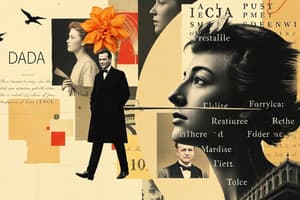Podcast
Questions and Answers
What was the Harlem Renaissance?
What was the Harlem Renaissance?
- A series of literary works written by French authors exploring African themes
- A musical genre popularized by African-American artists in the 1960s
- A period of artistic and cultural flourishing in the African-American community of Harlem, New York, during the 1920s and 1930s (correct)
- A political movement aimed at securing voting rights for African-Americans
Which of the following was NOT a prominent writer associated with the Harlem Renaissance?
Which of the following was NOT a prominent writer associated with the Harlem Renaissance?
- Langston Hughes
- Countee Cullen
- Toni Morrison (correct)
- Zora Neale Hurston
What was the significance of the Harlem Renaissance for African-American identity and culture?
What was the significance of the Harlem Renaissance for African-American identity and culture?
- It rejected African-American folk culture and traditions
- It focused solely on political activism and civil rights issues
- It encouraged assimilation into mainstream American culture
- It articulated new modes of African-American experience and experimented with artistic forms (correct)
Which of the following publications was NOT associated with the Harlem Renaissance?
Which of the following publications was NOT associated with the Harlem Renaissance?
What influence did the Harlem Renaissance have beyond the United States?
What influence did the Harlem Renaissance have beyond the United States?
Which of the following is NOT true about the Harlem Renaissance?
Which of the following is NOT true about the Harlem Renaissance?
Which of the following works is considered a seminal publication of the Harlem Renaissance?
Which of the following works is considered a seminal publication of the Harlem Renaissance?
What was the significance of the essay "The Negro Artist and the Racial Mountain" by Langston Hughes?
What was the significance of the essay "The Negro Artist and the Racial Mountain" by Langston Hughes?
What is the relationship between the Harlem Renaissance and the works of Edgar Allan Poe?
What is the relationship between the Harlem Renaissance and the works of Edgar Allan Poe?
Which of the following statements about the Beat Generation is true, based on the provided information?
Which of the following statements about the Beat Generation is true, based on the provided information?
Flashcards are hidden until you start studying
Study Notes
Elizabethan Period (1558-1603)
- Queen Elizabeth saves England from Spanish invasion and internal squabbles
- Early works of Shakespeare, Marlowe, Kyd, and Sidney emerge during this period
Jacobean Period (1603-1625)
- Later works of Shakespeare
- Writers like Aemilia Lanyer, Ben Jonson, and John Donne emerge during this period
Caroline Age (1625-1649)
- John Milton, George Herbert, Robert Herrick, and the "Sons of Ben" write during this period
- Reign of Charles I and his Cavaliers
Puritan Period (1649-1660)
- Under Cromwell's Puritan dictatorship
- John Milton continues to write, along with Andrew Marvell and Sir Thomas Browne
Characteristics of the Renaissance Age
- Reforms in institutions
- Reason dominates over religion
- Man-centered society
- Development of science and mathematics
- Era of renowned names in literature, including Shakespeare, Marlowe, and Milton
The Enlightenment (1660-1790)
- An intellectual movement in France and Europe
- Emphasized reason, progress, and liberty
- Associated with nonfiction writing, such as essays and philosophical treatises
- Major Enlightenment writers include Thomas Hobbes, John Locke, and René Descartes
Romanticism (1798-1832)
- A literary and artistic movement that reacted against the Enlightenment
- Celebrated spontaneity, imagination, subjectivity, and nature
- Notable English Romantic writers include Jane Austen, William Blake, and Lord Byron
- Prominent figures in the American Romantic movement include Nathaniel Hawthorne and Herman Melville
Victorian Era (1832-1901)
- A period of English history between the passage of the first Reform Bill and the death of Queen Victoria
- Notable Victorian novelists include the Brontë sisters, Charles Dickens, and George Eliot
- Prominent poets include Matthew Arnold, Robert Browning, and Elizabeth Barrett Browning
Modernism (1890s-1940s)
- A literary and artistic movement that provided a radical break with traditional modes
- Major themes include the attack on notions of hierarchy, experimentation in new forms of narrative, and doubt about the existence of knowable reality
Metaphysical Poets
- A group of 17th-century poets whose works are marked by philosophical exploration and colloquial diction
- John Donne is the foremost figure, along with George Herbert, Andrew Marvell, and Abraham Cowley
Symbolist Movement
- A group of late 19th-century French writers who favored dreams, visions, and the associative powers of the imagination
- Believed that the purpose of art was not to represent reality but to access greater truths
- Influenced by Edgar Allan Poe's works
Harlem Renaissance (1920s-1930s)
- A period of musical, literary, and cultural proliferation in New York's African-American community
- Key to developing a new sense of Black identity and aesthetics
- Writing luminaries include Langston Hughes, Countee Cullen, and Zora Neale Hurston
The Beat Generation
- A literary movement started by a group of authors whose work explored and influenced American culture and politics in the post-war era
Studying That Suits You
Use AI to generate personalized quizzes and flashcards to suit your learning preferences.




